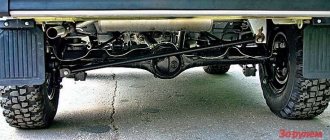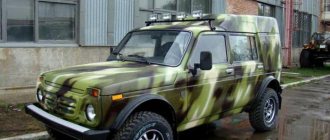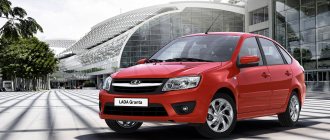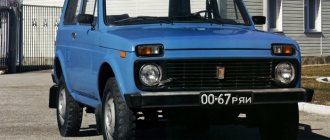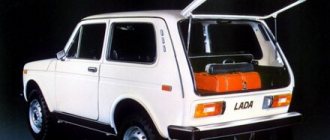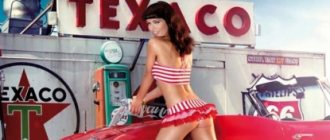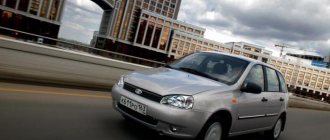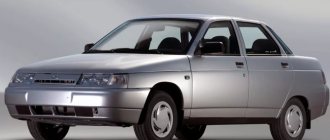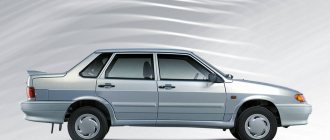It’s curious, but in more than 36 years of production, the notorious Niva has hardly changed, which, however, does not prevent it from being in stable demand, and not only in Russia. But if in our country it is the most affordable SUV on the market, then “over the hill” its cost is much higher. Let's say, in the same UK, the price tag for a LADA 4x4 starts at 13,000 British pounds, and this, excuse me, is almost five times more expensive than ours. At the same time, orders for the model do not subside. What can I say - the “dinosaur” is happily bought in more than a hundred countries around the world!
Although, in general, there is nothing to be surprised here - an ideal car for off-roading and practically indestructible. The main thing is that the future generation of SUVs does not degenerate into an ordinary city crossover, which is already disgusting, but retains all the advantages of its predecessor. True, we will have to wait at least three years for the new generation to be released, and it is possible that before the car goes on the assembly line, AVTOVAZ will change plans related to its modifications and modernization more than once. But everything has its time, but for now we suggest recalling the most successful modifications of the legendary “rogue” ever released.
VAZ 21218 “Fora”
Compared to the regular VAZ 2121, the Fora could boast of extended wheel arches, modified wheels, and also replaced the hard rear seats with a wide and comfortable sofa, borrowed from the V8. In addition, the car, produced at the PSA Bronto plant between 1996 and 2011, acquired doors enlarged by 300 mm and a roof raised by a plastic superstructure. As additional equipment, it was possible to order power steering, a protective “off-road” body kit, and even air conditioning.
VAZ 2131
An extended version of the model, which received five doors due to a half-meter insert into the standard body, due to which the distance between the first and second rows of seats increased by 125 mm. Of course, the wheelbase also increased in size, becoming 500 mm longer. Taking this into account, and not least because of the additional weight, the car began to accelerate noticeably worse and consume significantly more fuel. However, this did not stop post-Soviet buyers from lining up for it. However, you can buy such a car today. Moreover, now it has five-fold anti-corrosion protection for the paintwork, and CV joints have finally replaced the battered crosspieces in the driveline drive.
VAZ 212183 "Landole"
Until recently, this modification could also be purchased through pre-orders on the same PSA Bronto. The SUV, devoid of the upper part of the body, instead of which a power safety cage is installed, has become a kind of response to the American Jeep Wrangler. The usual trunk was replaced with an open side, and instead of doors, small plastic stops were installed to protect the interior from water and dirt. If necessary, the top was covered with a water-repellent tarpaulin, which, according to rumors, drained water no better than a colander in heavy driving rain. The picture was crowned by massive kangaroo pipes hanging around the entire perimeter of the car.
VAZ 2329 “Pickup”
A four-seater pickup truck with a wheelbase of 2700 mm, built on the basis of the five-door version of the Niva, received a rear overhang increased by 300 mm, as well as an additional fuel tank. Thus, the “all-terrain vehicle” with a carrying capacity of up to 650 kilograms began to contain as much as 84 liters of “fuel”. True, this had practically no effect on the power reserve. Another modification was produced in small quantities in a pickup truck body, only with a two-seater cabin - the VAZ 2328 “Wolf”. But unlike its “brother,” it did not gain popularity and was soon discontinued.
VAZ 21213 "Taiga"
The restyled variation of the VAZ 2121 in 1993 underwent changes, expressed in the new design of the rear lights and the long overhang of the trunk lid. In addition, the model gained contactless ignition, a Solex carburetor and, most importantly, a more powerful engine with a displacement of 1.7 liters. As for the interior, the cabin now features an updated instrument panel, fresher trim and softer seats. In this design, the car was to the taste of consumers and turned out to be no less popular than its predecessor.
Features of Niva Fora Bronto
The car is the brainchild of AvtoVAZ's subsidiary for the production of special vehicles - Bronto. The Niva Fora Bronto was first presented to the general public in 1998. Initially, this model was made specifically for cash collection in an armored version. The model with the VAZ 21218 index was called Force and was a mandatory vehicle in every banking institution.
The main difference from the traditional Niva is that the Fora has a 300 mm longer wheelbase. The body was cut in half and an additional piece of the specified size was inserted between the halves.
The result of the designers' work was, although not the most outstanding, but a harmonious design that stood out from the general background. As for the technical characteristics: the extension was done correctly, the joints are not located on one cross section, but are distributed along the entire length of the body. Strength parameters such as bending and torsion are completely preserved. The elongated door is one whole stamping - no separate elements connected to each other.
Extended varieties of "Niva"
VAZ-212180 “Fora”
VAZ-212180 “Fora” is a version of model 21213 extended by 300 millimeters. It was produced in small series from 1996 to 2005 (VIN code “X7G”). It differs from the base model in having wider doors and doorways, a raised rear roof due to a plastic superstructure and a wider rear three-seater seat type 2108. The standard equipment of the Fora includes an automatic fire extinguishing system in the engine compartment from the Force armored car, and surcharge - power steering, air conditioning and a plastic guard in front of the radiator grille. Due to the use of wheels of increased diameter (alloy wheels made from Togliatti with Nokian HRC tires), the spare tire is moved out of the engine compartment and secured above the rear bumper.
VAZ-212182 “Force”
VAZ-212182 “Force” is an armored cash-in-transit version of the VAZ-21218 model. In addition to the reservation system, it is additionally equipped with an automatic fire extinguishing system in the engine compartment and an explosion-proof fuel tank; additional battery, air conditioning, remote control of the right door lock from the driver's seat. An armored floor, beacons, etc. are offered as additional equipment. Since the Force is 430 kg heavier than the Fora, suspension springs made from a rod of increased diameter and reinforced shock absorbers are used.
VAZ-212183 "Landole"
VAZ-212183 “Landole” is an open beach SUV based on the “Fora” with a body type “Lando” or “Landole”. SPA BRONTO has been produced to individual orders since 1997. The absence of part of the roof and door pillars is compensated by an original load-bearing tubular frame, onto which, if necessary, a lightweight awning is attached or brackets are mounted for transporting large-sized sports equipment. The tailgate hinges on horizontal hinges. The interior is easy to clean (the seats are covered with leatherette, the floor is covered with soft linoleum). The exterior is complemented by an original plastic body kit and two-tone paint.
VAZ-2129
VAZ-2129 (unofficial name “Cedar”) is a model extended by 500 mm based on the standard VAZ-21213. “Kedr” was created in the early 90s as a carrier of units for the promising minivan VAZ-2120, but in 1992-1994. Produced in a small series at AvtoVAZ OPP. The body was lengthened due to the central insert. Served as the basis for the creation of the 5-door VAZ-2131 model.
VAZ-2129 “Utiliter”
VAZ 2129 “Utiliter” is a commercial modification of the “Cedar”. It differs from the base model in the absence of a rear seat and rear side windows barred from the inside. It was produced individually to order at AvtoVAZ OPP and was not distributed.
VAZ-2130
VAZ-2130 (“Cedar”) is a modification of the VAZ-2129 with a modified interior layout. The three-seater rear seat of type 2108 is moved forward. According to unverified information, the model index was subsequently changed to 2129-01. The VAZ-2130 was produced in small batches in 1993-1994. Served as the basis for the creation of the 5-door model VAZ-2131-01.
VAZ-2131 (LADA 4×4 5-door)
VAZ-2131 (LADA 4×4 5-door) is a five-door model extended by 500 mm based on VAZ-21213 units. Produced at Pilot Industrial Production of AvtoVAZ (OPP AvtoVAZ) since 1993. The VAZ-2131 was created on the basis of the 2129 Kedr model by adding a rear pair of doors. As of February 2009, 100 thousand VAZ-2131 have already been produced, which makes this model the second most popular in the old Niva family. The body is lengthened due to a central 500 mm insert into the standard body of model 21213. Accordingly, the wheelbase and length of the car change. On version 2131, the distance between the front and rear seats is increased by 125 mm, and on version 2131-01 a three-seater rear seat type 2108 is used. The fuel tank is increased to 70 liters. With the development of production of VAZ-2130 engines (1.8 l, 84 hp, 132 Nm) in the OPP, version 21312 with this engine was produced. Due to its characteristic appearance and the love of its manufacturers for the color green, the VAZ-2131 was popularly nicknamed the crocodile.
Advantages and disadvantages of the car
This modification of the Niva, called Fora Bronto, can give a head start to the base model, primarily in terms of comfort. The front seats remain the same, but the rear seats have moved 150 mm back. The remaining 150 mm goes to the luggage compartment, which in the standard version does not have a large volume. The rear wheel arches are also moved back and are now located behind the rear passengers and do not interfere with them.
Instead of a small double seat, there is a full-fledged sofa that can comfortably accommodate three people. The seats were completely borrowed from the VAZ 2108. The rear row passengers are no longer cramped, they can stretch their legs. The roof was raised, which allowed for more headroom.
When the body was lengthened, a large hatch was cut out in the rear part of the roof, which was subsequently covered with a plastic overlay of greater height. Seats for rear passengers have increased 3 times in height, length and width. The dimensions of the car cannot be compared to a full-fledged sedan, but it has become more comfortable to sit in the back. Cars with an extended wheelbase have a smoother ride. Niva Fora confirms this by her own example.
The stability indicators of the modernized model have increased due to an increase in the distance between the front and rear axles. This is an important factor in the issue of passive safety. But a long wheelbase implies an increase in the cornering radius and a decrease in off-road qualities.
Extended body and its reliability
The body became longer, and it was lengthened using the most common method for AvtoVAZ. So, the base Niva is cut in half, and new parts are inserted into the structure. Naturally, this approach does not add reliability.
Therefore, at Bronto they decided not to use standard, proven technologies, but to take a different path. All non-standard elements were lengthened separately. Every detail was carefully calculated. This was done so that the body did not lose strength. Bronto engineers were careful not to end up with a weakened structure.
So, the sidewall was cut from below in the front part of the threshold. At the top, a cut was made at the back of the doorway. The floor was extended using a stepped insert. The roof was raised using reinforcements. Bronto assured that the VAZ-21218 Fora successfully passed all tests, the result was more than excellent. The strength and reliability characteristics of the design remained at the level of the basic Niva.
There are practically no welding seams and joints, as well as extension inserts on the body. However, you can feel the insert on the part of the roof that is covered by the top of the door.
The door is welded in two parts. The outer part of the structure is a monolithic steel sheet. The long doors in the Bronto even had additional opening handles for passengers in the back row. The glass is large enough - the size of the door. The inside of the part is finished with standard materials. What some owners don’t like is the lack of pockets for small items inside the door cards.
Design features of Fora
The total curb weight of the vehicle has increased by 75 kg compared to the standard version of the Niva. According to the experts who developed the model, a slight increase in weight made it possible to use the existing chassis design without the need to change the entire suspension. Only the springs and shock absorbers were replaced. The braking system remains unchanged: disc brakes at the front, conventional drums at the rear. The model is equipped with power steering.
Under the hood, a 1.7-liter power unit, standard for all modifications of the Niva, is installed. Nothing significant was added to the design of the engine, although it is frankly weak for an SUV. The transmission is a five-speed gearbox with permanent all-wheel drive. There is a center differential lock and a two-speed transfer case. The driveshaft has become longer. The handicap is equipped with oversized tires on cast aluminum wheels. Because of this, the spare wheel migrated from under the hood to a bracket mounted on the rear door. This move only improved the design of the car.
Another stylish addition is the bumper grille, which the owner can order as an additional option if desired. According to the manufacturer, today this grille is the only certified one. The Fora can be additionally equipped with an air conditioning or fire extinguishing system.
VAZ-21218. "handicap" gives a head start
An all-terrain vehicle is a fertile field for tuning: huge spotlights on the roof, a winch on the bumper, high or wide wheels - everything suits an all-wheel drive car.
Our Niva is no exception. That’s why there are so many options for its implementation today. Our correspondent in Tolyatti Sergei MISHIN introduces one of them - the brainchild of the production of special vehicles (PSA - a subsidiary of VAZ) "BRONTO". BRONTO cars appeared several years ago. Armored cars for collectors "Force", made on the basis of "Niva", settled in the fleets of many banks and have already become familiar. Inspired by the first success, the Bronto team began to expand the range of their vehicles and released the Marsh snow and swamp-going vehicle and an interesting version of the Niva, lengthened by 300 mm. They called her "Fora". By the way, along with “Force” and “Marsh” it was shown in Moscow at the last motor show, where it aroused considerable interest among visitors.
We have been following this project for a long time, and as soon as BRONTO received a certificate giving the right to sell Fora, the editors purchased this car for long-term testing (a bit expensive, though - 70 million rubles!). Today - about first impressions.
Like, presumably, many motorists who saw the extended version of the production car, we immediately wondered: how strong is the body and will it break in half under intensive use and excessive load? The creators of "Fora" assured that this will not happen. Knowing the Russian operating conditions and the peculiarities of the national character (for example, loading twelve bags of potatoes instead of the required five), the design was made especially durable.
Body elements are lengthened individually, and in such a way as not to weaken the entire structure. For example, the sidewall is cut at the bottom in front of the threshold, and at the top at the rear of the door opening. The floor is extended with a stepped insert, and additional reinforcing elements are introduced into the raised roof. “Fora” passed factory tests with excellent results: strength at the level of the serial “Niva”.
Article on the topic: Honda SRV 2022 owner reviews all disadvantages
And the comfort is much higher. Of the additional 300 mm, 150 went to increase the legroom for rear passengers, and the remaining 150 freed them from the cramped wheel arches that are so annoying on the Niva. The high ceiling and wide doorway allow passengers to enter the car, and not fit into the Niva. Since there is enough space for passage, the designers abandoned the standard front seats of the Niva in favor of “eight” seats.
The design of the elongated doors is curious. The cover (outer part) is a stamped sheet, and the frame is welded in two parts. The sliding glass is large, covering the entire door. The upholstery is original and has two handles. It looks, of course, unusual, but closing the doors and opening them is convenient for both front and rear passengers. It's a pity that there are no pockets in the doors for small items.
The body design, to the envy of Niva owners and to the delight of Fora owners, made it possible to increase the trunk volume. In the basic “2121” it is still too small. With the new cargo compartment, you don’t need to fold the rear seats so often (although here they are retracted as in a regular Niva). Even bulky cargo fits in the trunk without problems - there is more space than in the Samara. By the way, the compartment is closed by a “figure eight” shelf.
In the front part of the cabin, the instrument panel is normal, from the VAZ 21213. However, on our example there is a difference. On the right, instead of a magazine shelf, there is an air conditioner. The car buyer can order it directly from BRONTO. At first, we complained that there weren’t a lot of containers for things: the glove box is too small, the “trough” on the tunnel near the gearbox lever is small and inconvenient. But the summer heat, or rather the coolness inside the car, convinced us: air conditioning is more important.
An inexperienced eye will not immediately detect the Niva’s growth of 300 mm, but the unusual bump stop protecting the front of the car will certainly be noted. It looks good, is well secured and truly protects the car in difficult off-road conditions where you can bump into an obstacle. Test reports confirm this. The bump stop is certified, so not a single traffic police inspector will find fault with it.
Article on the topic: Huawei nova 2i owner reviews
There is also a spare tire behind the rear door. The reason for its relocation from under the hood is the possibility of installing wide tires. These won't fit under the hood anymore. It is secured to a folding bracket on the rear bumper. To open the trunk door, the spare wheel has to be lifted and folded down. It’s inconvenient, but to do it differently means to increase the price of an already expensive car.
Since there was free space under the hood, it would be a shame for it to go to waste - they decided at BRONTO and installed an automatic fire extinguishing system (gas generators) there. The thing, of course, is not cheap, but, as our experience shows, it is necessary. The flame, as a rule, breaks out under the hood, but the driver does not notice the fire immediately, but when it is raging with might and main. There are even worse situations when a fire occurs after an accident and the driver cannot get out of the car. It’s not for nothing that such systems are required in sports cars. The standby mode of the gas generators is indicated by two illuminated LEDs on the instrument panel, and in the event of a fire, sensors will be activated.
There are no more new products under the hood. There is a reliable 1700 cc VAZ 21213 engine with a carburetor, but now you can order a “Fora” with an injection engine.
The bottom of the car is also unchanged. Transmission: standard clutch, five-speed gearbox, transfer case, front and rear axles - everything is original. The exception is the driveshaft. Since the car was extended by 300 mm, an extended one was installed instead of the usual one.
When we examined the car from below, we decided to check the tightness of the threaded connections. Everything is put together conscientiously. Alas, today this cannot be said about VAZ’s serial (conveyor) products. It happens that they forget to install a nut or a bolt, and it’s inconvenient to even mention the tightening torque. This didn't happen before. After the first three thousand kilometers, we again “walked” through the entire car with the key. Everything was normal, as before. But there were some disappointments - such is the nature of domestic cars (and this forces you to always be on guard). Bubbles appeared in the expansion tank of our Fora. Suspecting something was wrong, they opened the cork and took a sniff. That's right, the smell of crankcase gases. This means that the head gasket is broken and they are breaking into the cooling system. It’s good that the “Antifreeze” didn’t manage to get into the oil. They took off the head cover, threw a wrench on the first bolt that came across, and it turned out to be. understretched. The same happened with others. They removed the head - the gasket, thank God, did not burn out, and gases escaped from the first cylinder past it into the cooling system. This defect puzzled us. The fact is that Zhiguli engines now use new bolts, similar to those in the VAZ 2108 engine. Tightening the head after a short run, as was before, is not required. The elastic deformation of the tightened bolts is sufficient to compensate for the shrinkage of the head gasket. This means that you should check the tightness yourself and immediately as soon as the new car falls into your hands.
Article on the topic: Lacetti station wagon reviews from owners
Another malfunction appeared a little later. Increased play in the steering mechanism. But we dealt with it quickly by turning the adjusting screw 1/6 of a turn. Otherwise, the car did not cause any trouble and evoked only positive emotions. The components and assemblies “broke in” already in the first thousand: a decrease in fuel consumption and an increase in overrun testified to this fact.
The car handles great on the road. It doesn’t jump like the short Niva, but easily “swallows” small irregularities on the asphalt, like a comfortable passenger car, and not a tough SUV. In a series of turns, the Fora handles perhaps better than the Niva. The increased turning radius is noticeable, because the wheelbase has grown from 2200 (on the Niva) to 2500 mm (on the Fora).
The Fora overcomes muddy dirt roads, sand, and plowing no worse than its prototype. There has not yet been a case where we have failed to get out of an off-road trap. We hope that the car will behave just as confidently in deep snow. Winter will tell. In the meantime, we were satisfied with the character of the “Fora”: the advantages of the car declared by the manufacturers were confirmed.
One of the gas generators of the automatic fire extinguishing system was installed in the standard place of the spare wheel.
The deflector in the Fora's plastic roof is designed to protect the glass from dirt.
To open the rear door, the spare wheel has to be folded up to the right.
The wide door opening and space for rear passengers are the main achievement of the BRONTO.
Because of the air conditioning, we had to sacrifice a magazine shelf.
Two handles on the door? Original.
Brief technical characteristics of the Fora car (in brackets - Niva VAZ 21213)
General data: number of places - 5 (4); curb weight - 1270 (1210) kg; total weight - 1720 (1610) kg; maximum speed - 135 km/h; acceleration time from zero to 100 km/h - 21 (19) s; fuel consumption at 90, 120 km/h and in GC - 8.5 (8.3); 11.5; 11.0 (10.3) l/100 km. Dimensions, mm: length - 4190* (3749); height - 1750 (1640); base - 2500 (2200).
Article on the topic: Volkswagen Passat SS owner reviews 2012
Technical parameters of VAZ 212180
The base model of the VAZ 21213 was taken as a basis; there are three doors in the car, the wheel formula is 4x4. The Fora is 4.4 m long, 1.68 m wide, 1.75 m high, the distance between the wheel axles is 2.5 m, and the ground clearance is 319 mm. Roof load – no more than 50 kg.
- trunk volume – 256 liters;
- tire size – R16 205/75 and 175/80;
- engine - volume 1.7 liters, power 80 liters. s., torque – 128 Nm, acceleration from zero to “hundreds” in 20 seconds. Maximum speed – 140 km/h;
- transmission – 5-speed manual;
- vehicle weight – 2270 kg, maximum load – 450 kg;
- fuel tank volume – 42 l.
Other models based on Niva
VAZ-2328 "Wolf"
VAZ-2328 “Wolf” is a pickup truck with a short 2-seater cab based on the VAZ-2131 model. It was supposed to go into production in parallel with the VAZ-2329 pickup truck, but due to low demand, LADA-Tul produced only an installation batch of Volkov.
VAZ-2329 “Bear”
VAZ-2329 “Bear”, “Niva Pickup”, LADA 4×4 Pickup - a pickup truck with an extended 5-seater cab based on the VAZ-2131 model, produced in small series at the VAZ production plant. The car retains its monocoque body (wheelbase 2700 mm) with a reinforced base and has a rear overhang increased by 300 mm. Load capacity is 650 kg. The VAZ-2329 retains the mechanical part from the VAZ-2129/2131. On request, instead of the VAZ 21213 engine, it was possible to install a VAZ-2130 engine (1.8 l, 84 hp). An additional fuel tank is provided, which brings their total capacity to 84 liters. The rear seat in the cabin is original and when folded forms a flat cargo area. The first releases of the pickup truck bore their own name “Bear”.
FVK-2302 "Bison"
FVK-2302 “Bison” is a pickup truck with a frame chassis based on Niva units. A pickup truck with a short double cab and a wooden platform was produced in small series by one of the small Tolyatti companies in 1993-1995. The reinforced rear suspension of the Bison was made with springs from the Volga and a rear axle from the UAZ
VIS-2346
VIS-2346 is a family of pickup trucks with a semi-frame chassis based on Niva units produced in Tolyatti, produced since 1996. Currently, two versions of the pickup truck are produced in small series: VIS-2346 with a short double cab and VIS-23461 with an extended 5-seater cab. Previously, the VIS-23464 pickup truck with a one-and-a-half four-seater cab and the VIS-2348 pickup truck with cabin panels from LADA Samara 2 were also produced. The reinforced rear suspension is made of springs.
BRONTO-1922 “March-1”
BRONTO-1922 “Marsh-1” is a snow and swamp-going vehicle (“pneumatic”) on ultra-low pressure wheels on VAZ-21213 units. It has been produced in small batches by JSC SPA BRONTO since 1997.
Lada 4x4 21214-0000070-20 “Niva Lynx”
“Niva Lynx” is actually a Lada 4x4, even more adapted for off-road driving.
The front suspension travel has been expanded, a spacer has been installed under the upper ball joint and front shock absorbers have increased travel by 25 mm. The travel of the rear shock absorbers has increased by 50 mm. “Lynx” received wheels with 235/75R15 tires with increased lugs. The wheel arches have been modified and rubber arch extensions have appeared.
To increase traction torque, a 4.1 gear pair was installed instead of the standard 3.9. Self-locking differentials are installed in the gearboxes.
One of the first copies of the car belongs to the Prime Minister of the Russian Federation V.V. Putin.
VAZ-21218. "Fora" gives a head start
Changes in external and internal design
Visually, the Niva Fora differs from the basic version in several characteristic details. The first is the long front door. The second is the roof, which has become larger and higher due to the plastic lining on top. The appearance began to resemble the legendary Land Rover Defender, only in the upper part of the roof there are no additional small windows. The third difference is the spare wheel, which, due to its large size, does not fit under the hood and is installed on the rear door - so the Fora has become even more like a jeep.
On the first models, the wheel hung on a low-quality bracket, which caused a lot of inconvenience to the owners. To open the trunk, you first had to lift the spare tire and then move it to the side. If the weather was rainy, or there had been an off-road trip before, such manipulations always ended with soiled clothes. The designers took this drawback into account and equipped the bracket with a lever, by pulling which you can easily tilt the wheel to the side.
Welds and joints are practically invisible to the naked eye, and the strength of the body remains the same. The doors have additional handles with which rear row passengers can open the door.
In the cabin, the upholstery of the door panels and seats is made of ordinary materials; the former still lack additional pockets for small items. The salon is no different from the base model - the interior is completely consistent with the regular version of the Niva. The gearshift knob is just as uncomfortable, the steering wheel is VAZ. Ergonomics remained at a low level - modernization did not change anything significantly. You can try to add an air conditioning system, but this will not achieve a feeling of comfort.
Many car owners have a reasonable question: “Is it worth buying a Niva Fora?” This modification costs almost twice as much as the regular version of the car. The changes that the SUV has undergone are clearly not worth the money they are asking for. The Niva with five doors is also cheaper than the Fora. There is no point in overpaying for the long body and characteristics of the standard version of the car.
One of the most interesting and respected creations of the domestic automobile industry is the Niva car. This Soviet and then Russian SUV was highly popular and was even exported to other countries of the world. Based on it, a considerable number of modifications were created, many of which are little-known, but very interesting.
The first Niva rolled off the assembly line in 1977 and immediately won the hearts of motorists. Under the hood was an in-line engine with a capacity of 80 horsepower per 1.6 liter. It was equipped with a four-speed gearbox. Slightly different models were sent for import - with a 1.3-liter engine.
Salon
You won't be able to find anything new in the interior of the VAZ-21218. Here is the interior of a regular Niva.
The same inconvenient gear selector, the same VAZ steering wheel, hard plastic and velor upholstery. In general, nothing has been done to the ergonomics; it is still “lame,” as noted by the owners’ reviews. But talking about ergonomics is not entirely correct - the car was designed 40 years ago. Even tuning won't help here. You can equip your car with air conditioning, but this will not completely solve the issue of comfort inside.
Deutsche Lada Niva Cabrio
German masters were interested in changing the Soviet Niva. So in 1983, based on this SUV, Deutsche Lada Automobil GmbH, which was the official importer of these cars, introduced a convertible, which completely lacked side pillars and roof strength elements. But a tubular frame appeared, with which they decided to strengthen the body.
The new version has front seats with head restraints, enhanced lateral seat support and seat belts. Additionally, plastic fender extensions were used, which were painted in the color of the car and gave it a more impressive look.
VAZ-21218 “Fora”: technical specifications, owner reviews, test drive
A lot of words have already been said about the VAZ-2121 Niva car. This is the first domestic comfortable SUV in the whole world.
How much do domestic car enthusiasts know about Niva? The five-door VAZ-2131 is being assembled from the assembly line in pilot production. But there are also intermediate versions on the roads of the country. This is the VAZ-2129 - a three-door modification with a long wheelbase, which has already been discontinued, and the VAZ-21218 "Fora". This car is very interesting. And despite the fact that it is no longer produced, the model is in demand among amateurs. The three-door body of the standard Niva is a bit cramped, but the five-door modification based on the VAZ-2121 is completely different. "Handicap" is something of a golden mean.
Bronto-1922-55 "Marsh-Combi"
This is a newly modified Niva car, which was transformed by specialists from Bronto. The basis of the transport was the bridges and frame of the UAZ-3151, but the body was used from the VAZ-21213. The first thing that catches your eye is the huge pneumatic wheels, which allow this vehicle to move on low-traffic soils, which is where the name “March” comes from, meaning “swamp” in French. The gearbox, engine and transfer case still remain from the Niva in this seriously updated SUV.
Engine and gearbox
Under the hood, as well as in the cabin, there are no changes. Here the owner is waiting for the already familiar VAZ engine model 21213. The power of the unit is 79 horsepower. The engine produces 127 Nm of torque. Since the Fora differs from the standard Niva in greater mass, acceleration to 100 km/h takes 21 seconds. The maximum speed is 135 km/h. The fuel consumption of the Fora is a full liter more than that of the standard Niva.
Previously, cash-in-transit vehicles had gas generators installed under the hood instead of a spare wheel to extinguish a fire; in the civilian version this option is not available due to the cheaper design.
The transmission and chassis also remain unchanged. The same five-speed manual transmission and transfer case are installed here. Drive axles – front and rear. Only the driveshaft is different - since the car is lengthened by 300 mm, instead of the standard shaft, an extended one was installed on the Bronto.
Comfort
The most important difference between the VAZ-21218 is, of course, the wheelbase, which was lengthened by 300 mm. The engineers also raised the roof slightly. These millimeters gained from the lift were used not to increase trunk volume, but to increase space in the cabin. The car also features wider doors. The owners know how difficult it is for an adult to get into the back row of a regular Niva. There is no such problem here - you can enter the car without problems.
Article on the topic: UAZ 31514 owner reviews
Despite the fact that the Fora is almost no different in appearance from the standard model, the difference is immediately felt inside. Now you don't have to bend over to get to the back seat. And the front seating position is quite comfortable.
Exterior
The Bronto modification is offered in two versions - Luxe and Prestige.
The Luxe package includes standard metal bumpers, roof rails, wheel arch extensions, and 15” wheels with MT tires.
In the Prestige version, in addition to the above, the car is equipped with an original radiator grille and massive plastic bumpers, sill protection, plastic wheel arch linings and fog lights.
For both modifications, additional certified equipment is available, such as installing a light panel on the roof, as well as a special “Camouflage” paint job.
The main differences between the Niva Bronto modification
:
- Rubber arch extensions or plastic body kit.
- Alloy wheels R15 and tires 235/75 R15 with active ground tread.
- The arches are carved and have anti-gravel protection.
- Railings.
- Decorative stickers on the sides.
- Fog lights.
- Plastic bumpers (internally reinforced with steel strips).
- Original radiator grille.
Article on the topic: Dobrynya all-terrain vehicle reviews from owners
VAZ-2123 and Chevrolet Niva
VAZ-2123
VAZ-2123 is a Russian compact SUV of the second generation, pilot production batches of which were produced at VAZ in 2001-2002. It maintained continuity with the old Niva in terms of units and received a new, more spacious five-door body. AvtoVAZ did not have the funds to introduce it into mass production, and as a result, the license for the VAZ-2123 and the rights to the Niva brand were sold to the General Motors concern.
Chevrolet Niva (Chevrolet Niva)
American designers made about 1,700 changes to the design of the VAZ-2123, which allowed the Chevrolet Niva to be considered an independent design. Since September 2002, after the launch of a joint production line with General Motors (OJSC JV GM-AvtoVAZ), the VAZ-2123 began to be produced under the Chevrolet Niva brand.
Chevrolet Niva (Chevrolet Niva) FAM-1
The first batch of Chevrolet Niva FAM-1 cars was released in the spring of 2006, production began in November 2006. The car received the VAZ-21236 index and was produced in a single GLX configuration. The car was equipped with an Opel Z18XE engine (1.8 l, 122 hp) and a 5-speed Aisin manual transmission (from Suzuki Grand Vitara), a new transfer case in a single unit with the gearbox. At the end of April 2008, the Chevrolet Niva FAM-1 model was discontinued. In two years, only about a thousand Chevrolet Niva FAM-1 were made and sold.
Chevrolet Niva Trophy (Chevrolet Niva Trophy)
There is a tuning modification “Trophy” (Chevrolet Niva Trophy), adapted for off-road use. The main differences from the basic configuration include a mechanical chain tensioner instead of a hydraulic one, installation of a snorkel to avoid water hammer when passing fords, forced shutdown of engine cooling fans, transmission breathers in the engine compartment, self-locking limited-slip differentials in gearboxes, main pairs with a gear ratio of 4.3 (instead of 3.9) in the transmission, a mechanism for attaching an electric winch.
“Handicap” – what is it?
“Niva Fora” is a three-door off-road vehicle with permanent all-wheel drive. The salon is made in the “Lux” configuration. The car can be used in any conditions. To achieve this, the designers equipped the model with everything possible. This is permanent all-wheel drive on all four wheels, differential locks, and high ground clearance. This model was first introduced in 1998. But all this is not the most important thing.
"Niva" has always been of interest to car enthusiasts as a good object for tuning. Spotlights were installed on the roof, the bumpers were equipped with winches, and the wheels had to have huge mud tires. There are many options for these models. engaged in the production of special vehicles. The company developed armored vehicles for the needs of cash collectors. They were called “Force” and were manufactured on the basis of the VAZ-2121. Bronto-mobiles were then in the fleets of all self-respecting banks. Article on the topic: Reviews from Peugeot 208 owners
But the company did not stop there and, after successfully developing a machine for banks, began expanding the range. An all-terrain vehicle called “Marsh” and the “Niva Fora”, extended by 300 mm, were released. Together with “Marsh” and “Force”, “Fora” was shown at the Moscow Motor Show in 1997. The model was then of great interest to fans of SUVs. After this, Bronto receives a certificate for the sale of Fora.
In short, “Fora” is the same “Force”, but without armor on the body (the so-called civilian version). Let's look at the features of this car.

